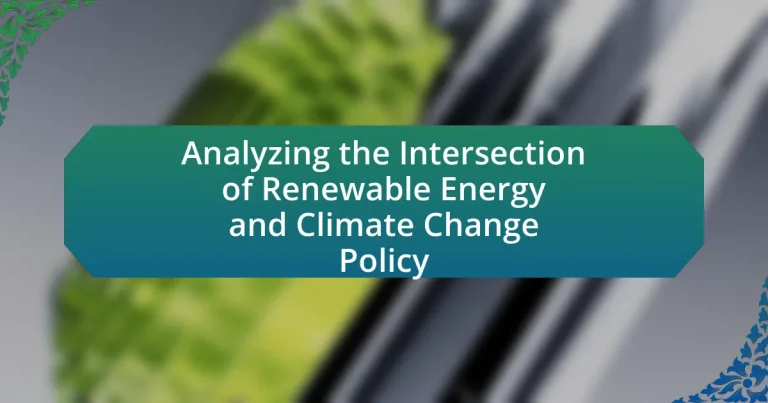The article analyzes the intersection of renewable energy and climate change policy, emphasizing the critical role of sustainable energy sources in mitigating climate change. It discusses how renewable energy technologies, such as solar and wind, contribute to significant reductions in greenhouse gas emissions and outlines the importance of supportive policies, including subsidies and regulatory frameworks, in promoting their adoption. The article also examines the challenges faced in implementing these policies, the impact of international agreements, and the varying approaches taken by different countries in integrating renewable energy into their climate strategies. Additionally, it highlights the future trends in renewable energy and climate change policy, focusing on technological innovations and the necessity for collaboration among stakeholders to ensure sustainable growth in the sector.

What is the Intersection of Renewable Energy and Climate Change Policy?
The intersection of renewable energy and climate change policy is the integration of sustainable energy sources into governmental strategies aimed at mitigating climate change. Renewable energy, such as solar, wind, and hydroelectric power, plays a crucial role in reducing greenhouse gas emissions, which are a primary driver of climate change. Policies that promote the adoption of renewable energy technologies, such as subsidies, tax incentives, and regulatory frameworks, are essential for transitioning away from fossil fuels. For instance, the International Renewable Energy Agency reported that doubling the share of renewable energy could help reduce global CO2 emissions by up to 70% by 2050. This demonstrates that effective climate change policies must prioritize renewable energy to achieve significant environmental benefits.
How do renewable energy sources contribute to climate change mitigation?
Renewable energy sources contribute to climate change mitigation by significantly reducing greenhouse gas emissions compared to fossil fuels. For instance, according to the International Renewable Energy Agency (IRENA), transitioning to renewable energy could reduce global carbon dioxide emissions by up to 70% by 2050. This reduction occurs because renewable energy technologies, such as solar, wind, and hydroelectric power, generate electricity without emitting carbon dioxide during operation. Furthermore, the deployment of renewables enhances energy efficiency and promotes sustainable practices, which collectively support global efforts to limit temperature rise and combat climate change.
What types of renewable energy are most effective in reducing greenhouse gas emissions?
Solar energy and wind energy are the most effective types of renewable energy in reducing greenhouse gas emissions. Solar energy systems, such as photovoltaic panels, convert sunlight directly into electricity, significantly lowering reliance on fossil fuels. According to the International Renewable Energy Agency (IRENA), solar energy has the potential to reduce global CO2 emissions by up to 4.5 gigatons annually by 2030. Wind energy, generated through turbines, also plays a crucial role; it can reduce emissions by approximately 2.5 gigatons per year, as reported by the Global Wind Energy Council. Both energy sources contribute to a substantial decrease in greenhouse gas emissions, making them pivotal in climate change mitigation strategies.
How does the adoption of renewable energy impact global temperature rise?
The adoption of renewable energy significantly reduces global temperature rise by decreasing greenhouse gas emissions. Transitioning from fossil fuels to renewable sources like solar, wind, and hydroelectric power lowers carbon dioxide emissions, which are a primary driver of climate change. For instance, a study by the International Renewable Energy Agency (IRENA) found that doubling the share of renewable energy in the global energy mix could help limit global warming to below 2 degrees Celsius, as outlined in the Paris Agreement. This shift not only mitigates temperature increases but also promotes sustainable development and energy security.
Why is climate change policy essential for promoting renewable energy?
Climate change policy is essential for promoting renewable energy because it establishes regulatory frameworks and incentives that drive investment and innovation in clean energy technologies. By setting emissions reduction targets and providing financial support, such as tax credits and subsidies, governments create a favorable environment for renewable energy development. For instance, the International Renewable Energy Agency reported that global renewable energy capacity increased by 10.3% in 2020, largely due to supportive policies. These policies not only facilitate the transition from fossil fuels to renewable sources but also help mitigate the adverse effects of climate change, thereby reinforcing the importance of renewable energy in achieving sustainability goals.
What role do government incentives play in the development of renewable energy technologies?
Government incentives are crucial in the development of renewable energy technologies as they provide financial support and regulatory frameworks that stimulate innovation and investment. These incentives, such as tax credits, grants, and subsidies, lower the cost of renewable energy projects, making them more attractive to investors and developers. For instance, the U.S. federal Investment Tax Credit (ITC) has significantly boosted solar energy installations, leading to a 167% increase in capacity from 2016 to 2020. Additionally, government policies that mandate renewable energy usage, like renewable portfolio standards, further drive the adoption of these technologies. Such incentives not only accelerate technological advancements but also contribute to job creation in the renewable sector, reinforcing the economic viability of transitioning to sustainable energy sources.
How do international agreements influence national renewable energy policies?
International agreements significantly shape national renewable energy policies by establishing binding commitments and frameworks that countries must adhere to. For instance, the Paris Agreement, adopted in 2015, requires signatory nations to set and achieve nationally determined contributions (NDCs) aimed at reducing greenhouse gas emissions, which directly impacts their renewable energy targets and investments. Countries often align their domestic policies with these international commitments to enhance credibility and attract foreign investment, as seen in the European Union’s Renewable Energy Directive, which mandates a specific percentage of energy to come from renewable sources by 2030. This alignment not only fosters a transition towards cleaner energy but also encourages technological innovation and collaboration among nations, reinforcing the global effort to combat climate change.
What challenges exist at the intersection of renewable energy and climate change policy?
Challenges at the intersection of renewable energy and climate change policy include regulatory barriers, financing issues, and technological limitations. Regulatory barriers often arise from outdated policies that do not accommodate new energy technologies, hindering the deployment of renewable sources. Financing issues stem from the high upfront costs associated with renewable energy projects, which can deter investment despite long-term savings. Technological limitations, such as energy storage and grid integration, pose significant challenges in ensuring a reliable and consistent energy supply from renewable sources. These factors collectively impede the effective implementation of climate change policies aimed at reducing greenhouse gas emissions and transitioning to sustainable energy systems.
What are the economic barriers to implementing renewable energy solutions?
The economic barriers to implementing renewable energy solutions include high initial capital costs, lack of financial incentives, and market volatility. High initial capital costs deter investment in renewable technologies, as projects often require significant upfront funding. For instance, the International Renewable Energy Agency reported that the average cost of solar photovoltaic systems can exceed $1,000 per installed kilowatt, which can be prohibitive for many stakeholders. Additionally, the absence of robust financial incentives, such as tax credits or subsidies, limits the attractiveness of renewable energy investments compared to fossil fuels, which often receive substantial government support. Market volatility further complicates the situation, as fluctuating energy prices can undermine the financial viability of renewable projects, making it difficult for investors to predict returns. These economic barriers collectively hinder the widespread adoption of renewable energy solutions.
How do political factors affect the effectiveness of climate change policies?
Political factors significantly influence the effectiveness of climate change policies by shaping legislative priorities, funding allocations, and public support. For instance, governments with strong political will and commitment to environmental issues tend to implement more robust climate policies, as seen in countries like Sweden, which has enacted comprehensive carbon pricing and renewable energy initiatives. Conversely, political opposition or lack of consensus can hinder policy implementation, as demonstrated in the United States, where shifts in administration have led to the rollback of climate regulations. Additionally, political stability and the presence of interest groups can either facilitate or obstruct climate action, impacting the overall success of policies aimed at mitigating climate change.

How do Different Countries Approach Renewable Energy and Climate Change Policy?
Different countries approach renewable energy and climate change policy through a variety of strategies tailored to their unique economic, environmental, and social contexts. For instance, Germany has implemented the Energiewende policy, which emphasizes a transition to renewable energy sources, aiming for 80% of electricity from renewables by 2050, supported by feed-in tariffs and substantial government investment. In contrast, China has rapidly expanded its renewable energy capacity, becoming the world’s largest producer of solar panels and wind turbines, driven by both domestic energy needs and international climate commitments. The United States has a more fragmented approach, with states like California leading in renewable energy initiatives while federal policies fluctuate based on administration priorities. These diverse strategies reflect each country’s specific goals, resources, and political landscapes, demonstrating a complex global landscape in addressing climate change through renewable energy.
What are the leading countries in renewable energy adoption?
The leading countries in renewable energy adoption are China, the United States, and Germany. China is the largest producer of renewable energy, generating over 1,000 gigawatts of renewable capacity, primarily from solar and wind sources. The United States follows with significant investments in wind and solar energy, contributing to approximately 20% of its electricity generation from renewables. Germany is a pioneer in renewable energy policies, achieving around 42% of its electricity from renewable sources in 2019, driven by its Energiewende initiative. These countries exemplify substantial commitments to renewable energy, reflecting their roles in global efforts to combat climate change.
How do these countries integrate renewable energy into their climate change strategies?
Countries integrate renewable energy into their climate change strategies by establishing policies that promote the development and deployment of renewable technologies, such as solar, wind, and hydroelectric power. For instance, Germany’s Energiewende policy aims to transition to a low-carbon economy by increasing the share of renewables in its energy mix to 80% by 2050, demonstrating a commitment to reducing greenhouse gas emissions. Similarly, Denmark has set ambitious targets to generate 50% of its electricity from wind power by 2020, showcasing a proactive approach to climate change mitigation. These strategies are often supported by financial incentives, regulatory frameworks, and international agreements, such as the Paris Agreement, which encourages nations to commit to renewable energy goals as part of their climate action plans.
What lessons can be learned from successful renewable energy policies worldwide?
Successful renewable energy policies worldwide demonstrate that strong government commitment, clear regulatory frameworks, and financial incentives are crucial for fostering growth in the sector. For instance, Germany’s Energiewende policy has led to a significant increase in renewable energy share, reaching over 40% of its electricity consumption by 2019, primarily through feed-in tariffs and long-term investment strategies. Additionally, countries like Denmark have shown that integrating renewable energy into the grid can be achieved through robust infrastructure and public-private partnerships, resulting in wind energy supplying around 47% of its total electricity in 2019. These examples highlight the importance of comprehensive planning, stakeholder engagement, and adaptive policy measures in successfully transitioning to renewable energy systems.
How do developing nations address renewable energy and climate change?
Developing nations address renewable energy and climate change by implementing policies that promote sustainable energy sources and reduce greenhouse gas emissions. For instance, countries like India and Kenya have invested in solar and wind energy projects, which not only provide clean energy but also create jobs and stimulate economic growth. According to the International Renewable Energy Agency (IRENA), renewable energy capacity in developing countries increased by 10% in 2020, demonstrating a commitment to transitioning away from fossil fuels. Additionally, many developing nations participate in international agreements, such as the Paris Agreement, to set emission reduction targets and receive financial support for climate adaptation and mitigation efforts. This collaborative approach helps them tackle the dual challenges of energy access and climate change effectively.
What unique challenges do developing countries face in implementing renewable energy solutions?
Developing countries face unique challenges in implementing renewable energy solutions, primarily due to limited financial resources, inadequate infrastructure, and regulatory barriers. Financial constraints hinder investments in renewable technologies, as many developing nations lack access to affordable capital and face high upfront costs for renewable energy projects. For instance, according to the International Renewable Energy Agency (IRENA), the cost of solar photovoltaic systems can be prohibitive for countries with low GDP per capita.
Inadequate infrastructure further complicates the deployment of renewable energy, as many regions lack the necessary grid systems to support new energy sources. The World Bank reports that over 1 billion people in developing countries still lack access to electricity, which limits the integration of renewable energy solutions.
Regulatory barriers also pose significant challenges, as inconsistent policies and lack of supportive frameworks can deter investment and slow down project implementation. A study by the United Nations Development Programme (UNDP) highlights that many developing countries struggle with policy coherence and institutional capacity, which are essential for fostering a conducive environment for renewable energy development.
How can international support enhance renewable energy efforts in these regions?
International support can enhance renewable energy efforts in these regions by providing financial resources, technology transfer, and capacity building. Financial assistance from international organizations, such as the Green Climate Fund, has allocated billions to developing countries, enabling them to invest in renewable infrastructure. Technology transfer initiatives facilitate access to advanced renewable technologies, which can improve efficiency and reduce costs. Additionally, capacity building programs help local stakeholders develop the skills necessary to implement and maintain renewable energy projects effectively. For instance, the International Renewable Energy Agency reported that such support has led to a significant increase in renewable energy capacity in regions like Sub-Saharan Africa, where installed renewable energy capacity grew by 10% in 2020 alone.
What role do local governments play in renewable energy policy?
Local governments play a crucial role in renewable energy policy by implementing regulations, promoting local initiatives, and facilitating community engagement. They are responsible for zoning laws that can either support or hinder renewable energy projects, such as solar farms or wind turbines. Additionally, local governments often create incentives, such as tax breaks or grants, to encourage the adoption of renewable energy technologies among residents and businesses. For instance, a study by the National Renewable Energy Laboratory found that local policies significantly influence the deployment of solar energy systems, demonstrating the impact of local governance on renewable energy growth.
How can local initiatives complement national climate change strategies?
Local initiatives can complement national climate change strategies by addressing specific community needs and implementing tailored solutions that align with broader goals. These initiatives often foster grassroots engagement, enabling local stakeholders to adopt renewable energy technologies, such as solar panels and wind turbines, which contribute to national emissions reduction targets. For example, the U.S. Department of Energy reported that local solar programs have significantly increased solar capacity in various states, demonstrating how localized efforts can enhance national renewable energy adoption. Additionally, local initiatives can serve as testing grounds for innovative policies and practices, providing valuable data and insights that inform national strategies.
What are some successful examples of local renewable energy projects?
Successful examples of local renewable energy projects include the Solarize program in Portland, Oregon, which has led to the installation of over 1,000 solar energy systems, significantly reducing carbon emissions. Another example is the community wind project in Hull, Massachusetts, where local residents invested in wind turbines that now provide approximately 80% of the town’s electricity needs. Additionally, the Brooklyn Microgrid in New York allows residents to buy and sell solar energy among themselves, promoting energy independence and sustainability. These projects demonstrate effective local engagement and substantial contributions to renewable energy generation.

What Future Trends Can We Expect in Renewable Energy and Climate Change Policy?
Future trends in renewable energy and climate change policy will increasingly focus on decarbonization, technological innovation, and international cooperation. Governments are committing to net-zero emissions targets, with over 130 countries pledging to achieve this by mid-century, which drives investments in renewable technologies such as solar, wind, and energy storage. The International Energy Agency reported that renewable energy capacity is expected to grow by 50% by 2024, highlighting the shift towards cleaner energy sources. Additionally, policies will likely emphasize carbon pricing mechanisms and incentives for sustainable practices, as evidenced by the European Union’s Green Deal, which aims to make Europe the first climate-neutral continent by 2050. These trends indicate a robust alignment between renewable energy advancements and climate change mitigation efforts.
How is technology shaping the future of renewable energy?
Technology is significantly shaping the future of renewable energy by enhancing efficiency, reducing costs, and enabling innovative solutions for energy generation and storage. For instance, advancements in solar panel technology, such as bifacial panels and perovskite materials, have increased energy conversion rates, making solar power more viable. According to the International Renewable Energy Agency (IRENA), the cost of solar energy has dropped by 89% since 2009, demonstrating the impact of technological innovation on affordability. Additionally, developments in battery storage technology, like lithium-ion and solid-state batteries, are improving energy storage capabilities, allowing for better integration of renewable sources into the grid. This integration is crucial for addressing intermittency issues associated with wind and solar energy, thereby facilitating a more reliable energy supply. Overall, technology is driving the transition to a more sustainable energy landscape by making renewable energy sources more accessible and efficient.
What innovations are emerging in renewable energy technologies?
Emerging innovations in renewable energy technologies include advancements in solar photovoltaic efficiency, energy storage solutions, and offshore wind energy systems. For instance, perovskite solar cells have demonstrated efficiencies exceeding 25%, significantly improving energy capture compared to traditional silicon cells. Additionally, lithium-sulfur batteries are being developed to enhance energy storage capacity, potentially offering five times the energy density of current lithium-ion batteries. Offshore wind technology has also progressed, with floating wind turbines enabling energy generation in deeper waters, thus expanding the potential for wind energy production. These innovations are crucial for meeting global energy demands while addressing climate change challenges.
How might advancements in energy storage impact renewable energy adoption?
Advancements in energy storage significantly enhance renewable energy adoption by addressing the intermittency issues associated with sources like solar and wind. Improved storage technologies, such as lithium-ion batteries and emerging solid-state batteries, allow for the efficient capture and retention of energy generated during peak production times, making it available for use when demand is high or generation is low. For instance, the International Renewable Energy Agency (IRENA) reported that energy storage capacity could increase by 1,000% by 2040, facilitating a more reliable and stable energy supply. This reliability encourages investment in renewable infrastructure, ultimately leading to a higher percentage of renewables in the energy mix and supporting climate change mitigation efforts.
What are the potential impacts of climate change on renewable energy policies?
Climate change significantly influences renewable energy policies by necessitating increased investment in clean energy technologies and infrastructure. As global temperatures rise and extreme weather events become more frequent, governments are compelled to adopt policies that promote renewable energy sources to mitigate greenhouse gas emissions. For instance, the Intergovernmental Panel on Climate Change (IPCC) emphasizes that transitioning to renewable energy is essential for limiting global warming to 1.5 degrees Celsius, which has led many countries to implement ambitious renewable energy targets and incentives. Additionally, climate change impacts, such as shifting weather patterns, can affect the reliability and efficiency of renewable energy sources, prompting policymakers to adapt regulations and support research in energy storage and grid resilience.
How might extreme weather events influence energy infrastructure and policy decisions?
Extreme weather events significantly influence energy infrastructure and policy decisions by exposing vulnerabilities and prompting regulatory changes. For instance, hurricanes and floods can damage power plants and transmission lines, leading to increased investment in resilient infrastructure. The National Oceanic and Atmospheric Administration reported that in 2020, the U.S. experienced 22 separate billion-dollar weather and climate disasters, highlighting the urgent need for policies that prioritize climate resilience in energy systems. Consequently, policymakers may implement stricter building codes, incentivize renewable energy sources, and enhance grid reliability to mitigate future risks associated with extreme weather.
What adaptations are necessary for renewable energy systems in a changing climate?
Adaptations necessary for renewable energy systems in a changing climate include enhancing infrastructure resilience, optimizing energy storage solutions, and diversifying energy sources. Infrastructure resilience is critical as extreme weather events can damage solar panels, wind turbines, and transmission lines; for instance, the National Renewable Energy Laboratory reports that climate-related disruptions can lead to significant energy supply losses. Optimizing energy storage solutions, such as advanced battery technologies, is essential to manage variability in renewable energy generation due to changing weather patterns. Diversifying energy sources, including integrating geothermal and hydropower, can mitigate risks associated with reliance on a single energy type, ensuring a more stable energy supply in fluctuating climate conditions.
What best practices can be adopted for effective renewable energy and climate change policy?
Effective renewable energy and climate change policy can be achieved by adopting a multi-faceted approach that includes setting ambitious yet achievable targets, promoting technological innovation, and ensuring stakeholder engagement. Setting clear targets, such as the commitment to achieve net-zero emissions by 2050, provides a framework for action and accountability. Promoting technological innovation, particularly in solar, wind, and energy storage, is crucial as it drives down costs and increases efficiency; for instance, the cost of solar energy has dropped by over 80% since 2010. Ensuring stakeholder engagement, including collaboration with local communities, businesses, and governments, fosters support and facilitates the implementation of policies. These practices are supported by evidence from various studies, including the International Renewable Energy Agency’s report, which highlights the importance of integrated approaches in achieving sustainable energy transitions.
How can stakeholders collaborate to enhance policy effectiveness?
Stakeholders can collaborate to enhance policy effectiveness by establishing multi-sector partnerships that integrate diverse expertise and resources. For instance, government agencies, private companies, non-profit organizations, and community groups can work together to share data, align objectives, and develop comprehensive strategies that address both renewable energy and climate change challenges. Research shows that collaborative governance frameworks, such as those outlined in the “Collaborative Governance: A Guide for Public Managers” by Chris Ansell and Alison Gash, demonstrate improved policy outcomes through stakeholder engagement and shared decision-making processes. This collaborative approach not only fosters innovation but also ensures that policies are more responsive to the needs of various communities, ultimately leading to more effective implementation and greater public support.
What strategies can ensure sustainable growth in renewable energy sectors?
To ensure sustainable growth in renewable energy sectors, implementing a combination of policy support, technological innovation, and investment in infrastructure is essential. Policy support, such as tax incentives and renewable energy mandates, encourages investment and development in renewable technologies. For instance, countries like Germany have successfully increased their renewable energy share through feed-in tariffs, which guarantee fixed payments for renewable energy producers.
Technological innovation plays a critical role by improving efficiency and reducing costs of renewable energy systems. The International Renewable Energy Agency reported that the cost of solar photovoltaic systems has dropped by over 80% since 2010, making solar energy more accessible and competitive.
Investment in infrastructure, including smart grids and energy storage systems, is necessary to accommodate the variable nature of renewable energy sources. According to the U.S. Department of Energy, enhancing grid flexibility can significantly increase the integration of renewables, leading to a more resilient energy system.
These strategies collectively foster an environment conducive to sustainable growth in the renewable energy sector.




